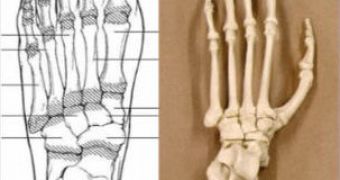Humans and apes have the same number of bones in their feet: 26. These bones are connected to one another by ligaments, connected to muscles by tendons which interact at 33 joints. But the moment we chose bipedalism (walking on two feet), our problems started.
Just a wrong trip or jump and we sprain our ankles or hips or we get a swollen knee. Our locomotion is unique amongst mammals: we are the only one relying on upright two-legged (bipedal locomotion). Kangaroos and some rodents can jump on two legs but cannot walk in this manner.
Our position is upright, with our center of gravity deep within the bowl of the pelvis, while our big heads nicely balance on a curved spine. To move forward, we simply lift a leg using the iliopsoas muscles, running from the spine and inside the pelvis to the top of the femur. The rest is just a matter of gravity.
The body goes forward, landing on a foot with a design made for taking the impact; our big toe lost the thumb function and is placed on line with the others forming a landing pad; the foot Arch plays the role of shock absorber.
This is a shocking contrast to what happens with our closest living relatives, chimps and gorillas. These apes lean forward, with most of their weight pressing on the tops of their knuckles as they move on the forest floor on their short legs. Their feet work like hands; they can grasp in the front and back, a good adaptation for tree life.
That's why walking upright is the trademark of our species; it is in fact the first recognizable trait that made us different from the other apes.
Fossil foot, leg and pelvic bones and footprints left in volcanic ash have revealed that our lower anatomy started to accommodate to upright walking at least 5 million years ago.
What exactly triggered and favored bipedalism is not clearly known. Perhaps we desperately needed to see over tall grass, as we are predominantly visual creatures. A recent research showed that two-legs walking wastes less energy than moving in four limbs. Many other theories are emitted.

 14 DAY TRIAL //
14 DAY TRIAL //